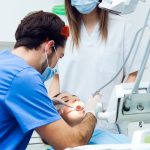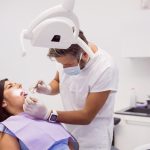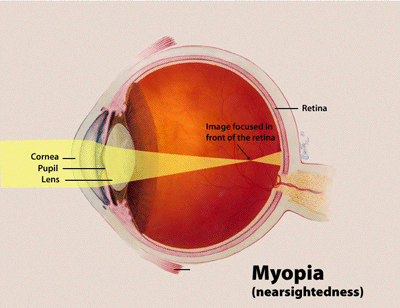In today’s screen-dominated world, the increasing use of smartphones, tablets, and computers has brought a silent epidemic to our doorsteps — Myopia, also known as nearsightedness. This vision condition is particularly growing at an alarming rate among teenagers, with recent studies labeling it a global public health issue. But what exactly is myopia, why is it on the rise, and how can you protect your child’s vision?
What is Myopia?
Myopia is a refractive error where distant objects appear blurry, while near objects are seen clearly. This happens when the eyeball is too long or the cornea is too curved, causing light rays to focus in front of the retina rather than directly on it.
While myopia can be inherited, lifestyle factors like excessive screen time, lack of outdoor activity, and continuous near work (like reading or watching on mobiles) are driving a dramatic rise in myopia cases, especially among adolescents.
Why is Myopia Increasing in Teenagers?
Teenagers today are living in a hyper-connected digital world. Online learning, video games, social media, and prolonged smartphone usage have led to extended hours of near work with minimal outdoor exposure. These lifestyle changes contribute to early onset and faster progression of myopia.
Major risk factors include:
- Prolonged screen time (phones, tablets, laptops)
- Lack of natural sunlight due to indoor confinement
- Genetics – having one or both parents with myopia
- Continuous near work without breaks (studying, reading)
- Poor posture and lighting while using devices
Symptoms of Myopia in Teenagers
Myopia often goes unnoticed in its early stages. As a parent, it’s important to stay alert for subtle signs such as:
- Squinting to see far objects (TV, blackboard)
- Sitting too close to the screen or books
- Frequent headaches or eye strain
- Complaints of blurred vision, especially at night
- Poor performance in sports or outdoor activities
- Rubbing eyes frequently or excessive blinking
If any of these signs appear, it’s essential to schedule a comprehensive eye examination.
Long-Term Effects of Untreated Myopia
Myopia isn’t just about wearing glasses. If not properly managed, it can lead to high myopia, which carries serious risks including:
- Retinal detachment
- Glaucoma
- Cataracts
- Macular degeneration
- Permanent vision loss
Early intervention can slow down or prevent these complications.
How to Diagnose Myopia?
Diagnosis involves a simple, non-invasive eye examination by an ophthalmologist or optometrist. At Chetna Hospital, we use advanced tools to assess your child’s visual acuity, eye shape, and refractive error.
We also examine whether your teenager is at risk for progressive myopia and offer customized treatment plans accordingly.
How is Myopia Treated?
1. Prescription Glasses or Contact Lenses
These are the most common and effective ways to correct vision in mild to moderate myopia.
2. Orthokeratology (Ortho-K) Lenses
These are special hard contact lenses worn overnight to reshape the cornea temporarily and reduce dependence on daytime glasses.
3. Low-Dose Atropine Eye Drops
Clinically proven to slow myopia progression in children and teens. These drops are safe, with minimal side effects when prescribed correctly.
4. Multifocal Contact Lenses
Designed to reduce strain and slow progression in growing eyes.
5. LASIK or Refractive Surgery
An option for adults with stable myopia. Not suitable for teenagers, as their eyes are still developing.
How to Prevent or Slow Down Myopia in Teenagers
While genetics can’t be controlled, you can definitely reduce lifestyle risks. Here’s how:
✅ 1. Limit Screen Time
Encourage breaks during device use. Follow the 20-20-20 rule – every 20 minutes, look at something 20 feet away for 20 seconds.
✅ 2. Encourage Outdoor Activities
At least 1-2 hours of outdoor play daily helps in healthy eye development. Natural light plays a protective role against myopia.
✅ 3. Proper Lighting and Posture
Ensure children use devices or study in well-lit environments with upright posture.
✅ 4. Avoid Late-Night Screen Use
Blue light exposure before sleep strains the eyes and disturbs sleep cycles.
✅ 5. Schedule Regular Eye Exams
Early detection can make a huge difference. Get your teenager’s eyes checked every 6–12 months, especially if they’re showing symptoms.
When to See a Doctor?
Don’t wait until your child complains. If there’s a family history of myopia, or if your teen shows any symptoms, consult an eye specialist without delay.
📍 Chetna Hospital, Sambhajinagar, Chinchwad offers specialized paediatric and teenage eye care services, with advanced diagnostic tools and personalized treatments.
Contact us on 9168690448 / 9158681123
Website – www.chetnahospital.co.in
Sambhajinagar, MIDC, G Block, Near Rotary Club, Chinchwad 411019
.
.
.
#hospital#pune#pcmc#chinchwad#medical#medicalservices#dryeyetreatment#dryeyerelief#dryeyedisease#dryeyetherapy#catract#catractsurgery#catracteyesurgery#catracteyeoperation#eyedoctor#eye#glaucoma#conjunctivitis#ophthalmologist#eyediseases#eyepain#pinkeye#hazeleyes#myopia#eyeinfection#amblyopia#dryeyesyndrome#eyeproblems#motibindu#motibinduoperation













